Hi Friends, and Happy 2025!
There’s something magical about the first few days of a new year. The air feels lighter, brimming with optimism and the hope for fresh starts and betterment. This year, I find myself more ready than ever for what’s ahead and excited for the adventure that awaits.
On New Years Eve of 2023, as the clock ticked down to midnight, fireworks bursting in the distance, I joined in the cheers, raised a glass of bubbly, and toasted to the future. What I didn’t realize in that moment was that the sparkling wine in my hand would be my last sip of alcohol—not just for the night, but for the year.
This wasn’t a meticulously planned decision. I didn’t announce it to the world or add “quit drinking” to my list of resolutions. It wasn’t part of my 2024 Ins and Outs. Instead, it unfolded quietly, naturally. As I reflect on the past 365 days without alcohol, I can see how a series of choices led me here—one of the best decisions I’ve ever made.
Now, after a year of living booze-free, I’ve come to understand so much about myself, my habits, and the culture around drinking. Whether you’re sober-curious, considering taking a break, or just looking to reset your system for better health, I’m excited to share what I’ve learned. Below, you’ll find the highs, lows, and surprising truths from my alcohol-free experiment.

As I approached the final stretch of my twenties, I felt the urge to make a significant change before turning 30. Among the many decisions swirling in my mind, one stood out: getting off birth control. While I'll save the details of that journey for another time, this choice became the catalyst for a broader focus on my hormone health—a priority I knew I couldn’t delay any longer.
I’d heard enough horror stories from friends to be wary of what lay ahead: cystic acne, heavier periods, weight fluctuations, and mood swings. Determined to face the transition armed with knowledge and support, I partnered with a Naturopath to guide me through it. Over the course of the year, I underwent a comprehensive health investigation: four blood tests, two gut tests, a hormone panel, and a thyroid test.
The results were eye-opening. I was diagnosed with Adrenal PCOS, a specific form of Polycystic Ovary Syndrome characterized by the overproduction of adrenal androgens, particularly dehydroepiandrosterone sulfate (DHEA-S). Essentially, my stress was fueling my PCOS symptoms, and the solution required more than medication—it demanded a complete lifestyle shift.
To mitigate post-pill symptoms and manage my PCOS, I embarked on a strict elimination diet. Soy, corn, and dairy were the first to go, followed by gluten, which I cut out for nearly six months. My Naturopath prescribed a protocol of supplements and emphasized the importance of restorative sleep: 8-9 hours every night became my new non-negotiable.
Recognizing the impact of alcohol on hormone health, I decided to start the year with a sober January and February. To my surprise, when March arrived, I didn’t feel the urge to drink. One month turned into two, and before I knew it, summer had arrived. The longer I abstained, the easier it became to resist.
By June, I had hit the six-month mark without alcohol. It hadn’t been as difficult as I’d anticipated, so I decided to keep going. Month by month, I watched my resilience grow. October arrived, and with it, the realization that I was only three months away from a full year of sobriety. Determined to see it through, I powered through the holiday season, staying committed to my health.
This year wasn’t just about cutting out alcohol or following a health protocol—it was about reclaiming control over my body and making choices that aligned with the future I wanted. By the end of 2024, I had more than just improved hormone health; I had gained confidence in my ability to prioritize myself and navigate life’s challenges with strength and intention.
How Does Alcohol Metabolize
A big reason I decided to quit alcohol as part of my wellness protocol was because once I learned the truth about how it affects our bodies, I couldn’t ignore it any longer.
Here’s the kicker: did you know that once you reach that “buzzed” feeling, you’ll never get it back? Here’s how it works: when you’re drinking, you hit that sweet spot—feeling good, loose, and euphoric—and it’s that surge of dopamine that pulls you back to the bar for another drink, chasing that same feel-good moment. But here’s the truth: after that peak, no matter how much more you drink, you can never quite reach that same high again. All you’re left with is the aftermath—hangovers, bad moods, and a wasted day ahead.
Once I realized this, it clicked for me. I wasn’t just chasing a buzz; I was stuck in a cycle of diminishing returns, always looking for something I couldn’t recapture. The more I understood about how alcohol truly works in the body, the clearer it became that quitting was the right choice for me.
How Alcohol Works/ Is Metabolized:
1. Absorption
Where: Alcohol is absorbed into the bloodstream through the stomach and small intestine.
Stomach: Around 20% of alcohol is absorbed here.
Small Intestine: The remaining 80% is absorbed through the intestinal lining.
Speed: The absorption rate is influenced by factors like the presence of food (which slows absorption), alcohol concentration, and the individual’s metabolic rate.
Alcohol is water and fat soluble which means that it can hit your bloodstream in as little as ten minutes if you’re drinking on an empty stomach.
2. Transport
Once absorbed, alcohol enters the bloodstream and is distributed throughout the body.
It crosses the blood-brain barrier, which is why alcohol affects brain function and behavior. This is where that buzzed feeling occurs, but only temporarily.
3. Metabolism
The liver is the primary site of alcohol metabolism, breaking down approximately 90% of the alcohol consumed. This occurs in two main steps:
Step 1: Conversion to Acetaldehyde
Enzyme Involved: Alcohol dehydrogenase (ADH).
Alcohol is converted into acetaldehyde, a toxic compound.
Acetaldehyde is responsible for many of the negative effects of drinking, like hangovers and tissue damage.
Step 2: Conversion to Acetate
Enzyme Involved: Aldehyde dehydrogenase (ALDH).
Acetaldehyde is further metabolized into acetate, a less harmful compound.
Acetate is then broken down into water and carbon dioxide, which are excreted from the body.
4. Excretion
Liver Metabolism: About 90% of alcohol is metabolized in the liver.
Excretion: The remaining alcohol is excreted unchanged through breath, sweat, and urine. This is the basis for breathalyzer tests.
Factors Influencing Alcohol Metabolism
Biological Sex: Women typically metabolize alcohol more slowly than men due to lower levels of ADH and higher body fat percentages.
Genetics: Variations in ADH and ALDH enzymes can affect how quickly alcohol is metabolized. For example, some people of East Asian descent have a genetic variation that slows acetaldehyde breakdown, causing flushing.
Body Size and Composition: Smaller individuals and those with less muscle mass metabolize alcohol more slowly.
Liver Health: Conditions like fatty liver disease or cirrhosis impair alcohol metabolism.
Rate of Consumption: Drinking faster than the liver can metabolize results in higher blood alcohol concentrations (BAC).
Metabolism Rate
The liver processes alcohol at a steady rate of about 1 standard drink per hour (roughly 0.015% BAC per hour). Drinking faster than this overwhelms the liver, leading to intoxication.
Sobering Lessons
I expected to feel good not drinking, however there were a lot of realizations in the aftermath of abstaining from alcohol that were unexpected.
I learned that I didn’t need alcohol to be social or have fun, even when friends questioned, "Are you even going to have fun?" The truth was, I had an amazing time—like celebrating my best friends’ wedding in Las Vegas, staying up until 3 a.m. and feeling completely present. I found that I could enjoy conversations more deeply, remembering every detail without the fog of alcohol.
Alcohol used to give me a false sense of confidence, but now I embrace being authentically myself. Even when I say something silly or make a mistake, I laugh it off instead of feeling insecure or anxious. I realized that I don’t need alcohol to feel comfortable or confident. I also discovered that I’m an extroverted introvert—socializing can drain me, especially if I’m around the wrong people or after a long day. So, I prioritize solo time and don't hesitate to leave the party early to recharge.
One of the biggest changes has been fully embracing mornings—protein-packed breakfast, journaling, meditation, early workouts, hikes, walks, and reading have become part of my routine, even on weekends. This shift in habits gave me the clarity to reassess my friendships. I noticed some of my old social circles only gathered for drinking, which didn’t align with my values anymore. This clarity allowed me to build a new community of like-minded people, and as a result, my relationships have become more fulfilling than ever.
I also realized that most people don’t care whether I drink or not—those who did were simply projecting their own relationship with alcohol onto me. And without alcohol, I became much better at managing my emotions. I used to think my anxiety was something I had to live with, but I realized that alcohol would often make it worse. Now, without it, I can name my emotions and move through them more easily.
The times I felt tempted to drink was after long days on film productions when the crew went out for drinks. I felt a sense of FOMO, but then I reminded myself that the celebration didn’t need alcohol to be valid. I had just shared a great experience with the team, and that was enough.
The video above was taken in Hermosillo, Mexico after a 19hr production with Carin Leon and AT&T.
And, of course, I saved a lot of money—between $1,000 and $3,000 on average—which I was able to put toward my Roth IRA. This decision helped me take a big step toward achieving financial freedom for my future self.
Here is a breakdown of how I got to that number:
1. Average Spending Per Drink
Bars/Restaurants: Drinks can range from $5 to $20 or more depending on location, type of drink, and venue.
Home Consumption: Bottles of wine, beer, or spirits vary widely but average $10-$30 per bottle.
2. Frequency of Drinking
Social Drinking: If you typically drink 2-3 drinks per week at $10 each, that’s $20-$30 weekly.
More Frequent Consumption: For those drinking 4-5 times a week, or consuming multiple drinks per occasion, the costs increase significantly.
3. Annual Estimate
Using a conservative estimate:
2 drinks/week at $10 each: $20 x 52 weeks = $1,040/year.
5 drinks/week at $10 each: $50 x 52 weeks = $2,600/year.
Frequent social outings with premium drinks: Could easily exceed $3,000-$5,000/year.
4. Additional Savings
Tips: Add 15-20% for tips at bars/restaurants.
Rideshare: Avoid the cost of Ubers/Lyfts to and from drinking venues.
Average Savings
For many moderate drinkers, the savings are around $1,000 to $3,000 per year, depending on consumption patterns and the cost of drinks in their area.
Tips For Having Fun While Being NA
If you’ve made it this far down this newsletter, and feel convinced that you want to take a break from alcohol, but still worried about whether or not you can achieve it, here are a few tips for ordering the perfect mocktail, and how to stay on track.
Thankfully, most places now offer delicious mocktails, allowing you to join in the fun without the hangover. My favorite mocktails were those with more botanical flavors, steering clear of overly sweet margarita-style mixers (which I had my fair share of while trying to order a mocktail). I gravitated toward drinks with a ginger beer base, accented by herbs like rosemary and mint, and brightened with citrus notes. If the menu didn’t offer any mocktail options, I’d simply go for club soda with bitters and lime or opt for a shrub.
Practice saying no. If you tend to give in easily to peer pressure, it's important to build the muscle for saying no comfortably. Remember, it’s better to disappoint someone else than it is to disappoint yourself. For me, a simple “I’m not drinking tonight” was usually enough.
And finally, if you’re out and feeling the urge to drink, reconnect with your “why.” Reminding yourself of the reasons you decided to cut back will be the strongest motivator to stay on track. This is your personal journey, and the only person who can truly make it happen is you. Stay committed to yourself, honor your intentions, and trust that your goals are worth it.
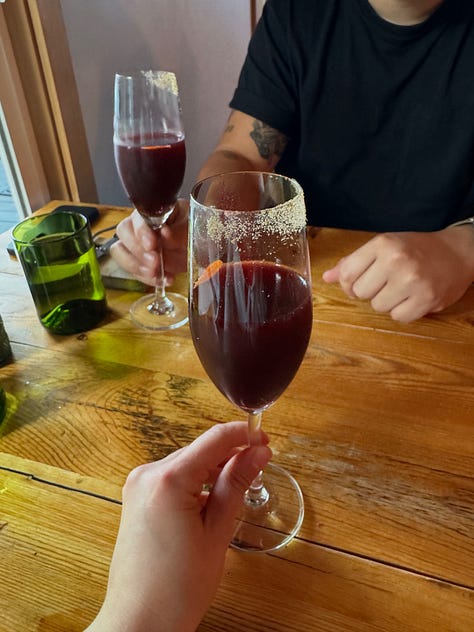
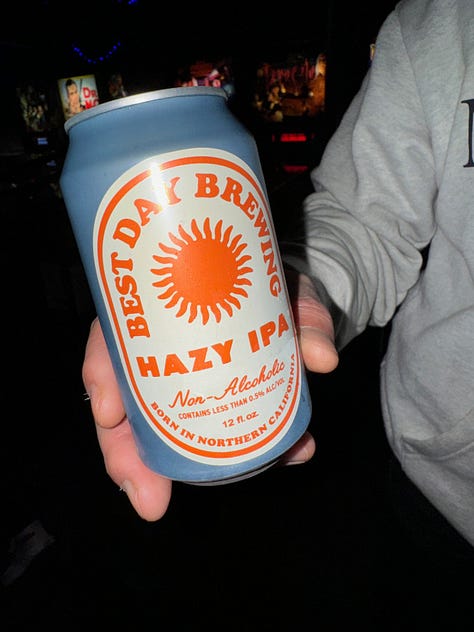
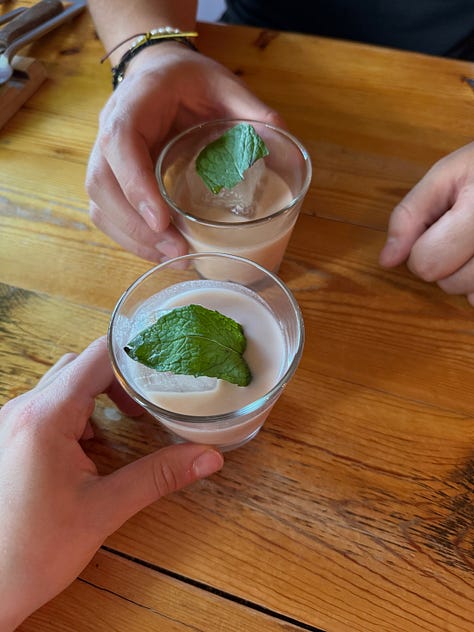
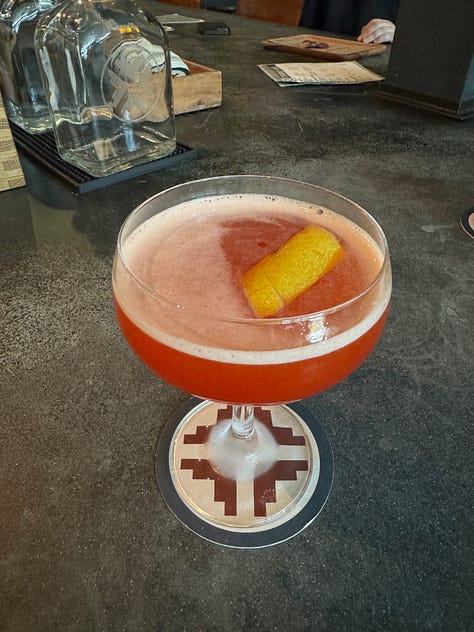

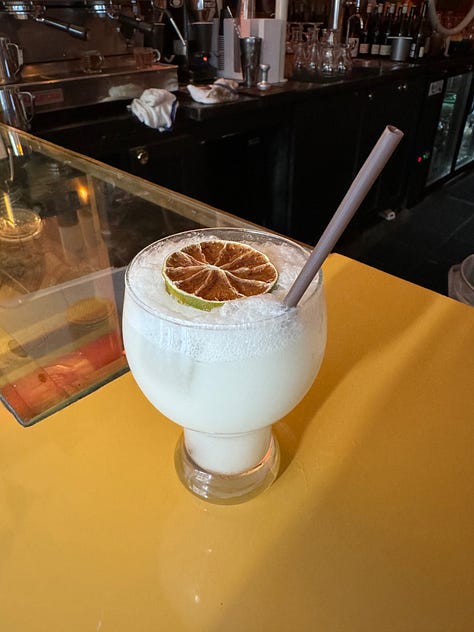
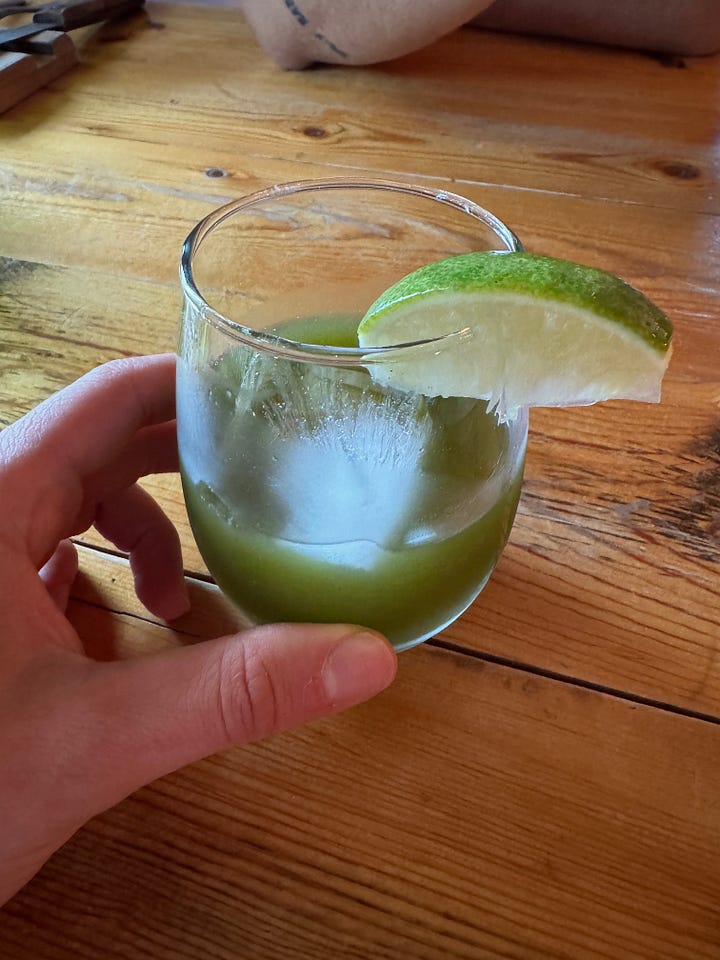
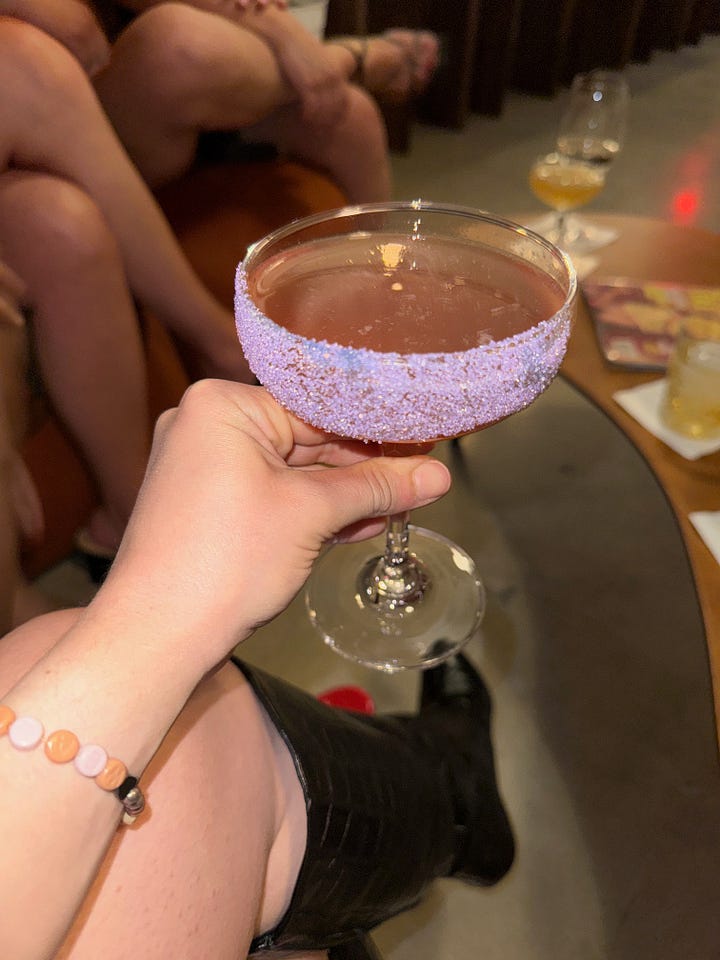
As I reflect on this year of sobriety, it’s not just about the health benefits or the clarity I’ve gained—it’s about embracing a new way of living, one where I’m in control of my choices and my future. Letting go of alcohol has allowed me to cultivate a deeper connection to myself, my health, and the relationships that truly matter. It’s been a journey of growth, self-awareness, and a little extra savings along the way!
If you’re considering taking a break from alcohol, remember that it’s a personal decision—one that can bring clarity, confidence, and fulfillment in ways you may not expect. Keep your “why” close, be kind to yourself in moments of temptation, and know that you have the power to create a life that aligns with your values and goals.
Cheers to a healthier, more intentional year ahead!




Thank you so much sweet friend! I appreciate your words so much and hope sharing our experiences can continue to inspire others to honor themselves and take the best care we possibly can!
I'm sorry to hear about your diagnosis. I know PCOS is no small thing. But love these reflections: how you've embraced change head-on and how being NA allows you to fill your cup even more meaningfully. You are doing what's best for you and to that I say, hell ya. You are an inspiration, my friend. Also those mocktails look so fun!